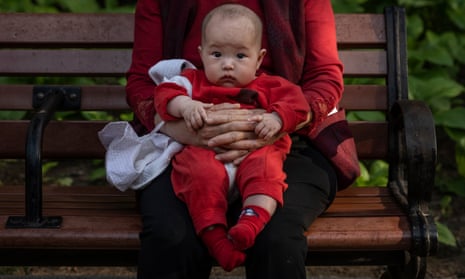Shift occurring nearly a decade ahead of forecasts heightens concerns over demographic time bomb

A woman holds a baby at a local park in Beijing, China. China’s population has shrunk for the first time since 1961.
Helen Davidson in Taipei and agencies Tue 17 Jan 2023
Helen Davidson in Taipei and agencies Tue 17 Jan 2023
China has entered an “era of negative population growth”, after figures revealed a historic drop in the number of people for the first time since 1961.
The country had 1.41175 billion people at the end of 2022, compared with 1.41260 billion a year earlier, the National Bureau of Statistics said on Tuesday, a drop of 850,000. It marked the beginning of what is expected to be a long period of population decline, despite major government efforts to reverse the trend.
Speaking on the eve of the data’s release, Cai Fang, vice-chairman of the Agriculture and Rural Affairs Committee of the National People’s Congress, said China’s population had reached its peak in 2022, much earlier than expected. “Experts in the fields of population and economics have predicted that by 2022 or no later than 2023, my country will enter an era of negative population growth,” Cai said.
China’s government has for several years been scrambling to encourage people to have more children, and stave off the looming demographic crisis caused by an ageing population. New policies have sought to ease the financial and social burdens of child rearing, or to actively incentivise having children via subsidies and tax breaks. Some provinces or cities have announced cash payments to parents who have a second or third child. Last week the city of Shenzhen announced financial incentives that translate into a total of 37,500 yuan ($5,550) for a three-child family.
However after decades of a one-child policy that punitively discouraged having multiple children, and rising costs of modern living, resistance remains among couples.
At a press conference on Tuesday, Kang Yi, head of the National Bureau of Statistics, said China’s overall labor supply still exceeded demand, and people should not worry about the population decline.
China is on track to be overtaken by India as the world’s most populous nation.
Last year’s birthrate was 6.77 births per 1,000 people, down from a rate of 7.52 births in 2021, marking the lowest birthrate on record. In real numbers, there were more than one million fewer registered births in 2022 than the previous year’s total of 10.62 million.
The country also logged its highest death rate since 1976, registering 7.37 deaths per 1,000 people compared with a rate of 7.18 deaths in 2021.
Cai said China’s social policies needed to be adjusted, including aged care and pensions, a national financial burden which would worsen in the future and impact China’s economic growth.
Online, some Chinese people were unsurprised by the announcement, saying the social pressures which were driving the low birthrate still remained.
“Housing prices, welfare, education, healthcare – reasons why people can’t afford to have children,” said one commenter on Weibo.
“Now who dares to have children, housing prices are so expensive, no one wants to get married and even fall in love, let alone have children,” said another.
“Not talking about raising social security, only talking about raising the fertility rate, it’s all just crap.”
On Tuesday China’s government also announced the GDP had grown 3% in 2022. That figure would mark one of the slowest periods of growth in decades, but was still higher than predicted, prompting some scepticism among analysts given the incredibly stringent zero-Covid658шг restrictions in place during the fourth quarter.
China’s stringent zero-Covid policies that were in place for three years before an abrupt reversal which has overwhelmed medical facilities, have caused further damage to the country’s bleak demographic outlook, population experts have said.
Yi Fuxian, an obstetrics and gynaecology researcher at the University of Wisconsin-Madison and expert on China’s population changes, said the decline in population was occurring almost a decade earlier than the country’s government and the United Nations had projected.
“Meaning that China’s real demographic crisis is beyond imagination and that all of China’s past economic, social, defence, and foreign policies were based on faulty demographic data,” Yi said on Twitter.
“China’s demographic and economic outlook is much bleaker than expected. China will have to undergo a strategic contraction and adjust its social, economic, defence, and foreign policies. China will improve relations with the West.”
2 comments:
анало гичная статья ввс:
Подробности, https://bbc.in/3XzbWKn
из=от туда;
В последние годы правительство Китая изо всех сил стимулирует рождаемость в стране разнообразными мерами - от налоговых льгот семьям с детьми до улучшения сферы охраны материнства.
Но пока усилия властей не отражаются на статистике рождаемости.
По мнению социологов, правительству надо пойти еще дальше и облегчить женщинам бремя ухода за детьми в виде дополнительных выплат и доступности дошкольного образования.
Кроме того, современные женщины хотят после рождения детей возвращаться к работе и учебе, и этот вопрос требует определенных реформ в области гендерного равенства.
В октябре 2022 года председатель КНР Си Цзиньпин, выступая на съезде Коммунистической партии (проводится раз в пять лет), заявил, что его правительство взяло курс на борьбу со старением населения и повышение уровня рождаемости.
Но, по словам экспертов, для достижения этих целей необходимо отказаться от многих консервативных взглядов на роль женщины в обществе, а китайские власти вряд ли к этому готовы.
Кроме того, считают экономисты, простое повышение уровня рождаемости не решит проблем, связанных с замедлением экономического роста Китая.
"Повышение рождаемости не приведет к повышению производительности или увеличению внутреннего потребления в среднесрочной перспективе", - говорит Стюарт Гитель-Бастен, профессор в области изучения государственной политики Гонконгского университета науки и технологий.
Гораздо важнее, на его взгляд, найти способы решения структурных проблем в экономике и внутренней политике.
Post a Comment